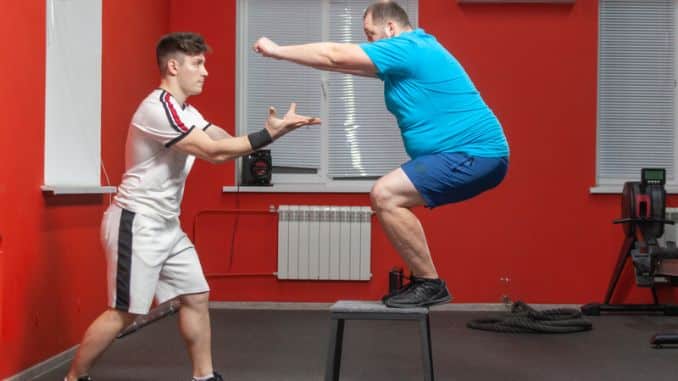
Today, I have an interview on Metabolic Training Secrets.
It is with Kate Vidulich.
Who is Kate Vidulich? What Kate Vidulich shares in the interview:
- What is metabolic training?
- What are the benefits of metabolic training?
- What are the common mistakes that people make when it comes to training to increase their metabolism?
- How can people add metabolic training within their program to increase their metabolism and speed up their fat loss results?
- Shared some inspiring results that her clients have gotten using the metabolic training program.
- Gave some points on how people can measure or track their intensity when it comes to their workout
Enjoy!
~ Rick
I am here for another video interview for you.
CLICK HERE to watch the video interview on Metabolic Training
(Sorry that the sound on Kate’s end was not perfect. Below is a transcript of the first half of the interview.)
Today we are going to talk about Metabolic Training. What is metabolic training? And how can it help you?
On the other line is Kate V. from New York. I will get Kate to introduce herself, and then we will get into the questions.
Kate Vidulich: Hey Rick, thank you so much for today’s new mood. I appreciate it.
Rick Kaselj: Awesome. So Kate, give people a little background on who you are. Because I know you are a misplaced individual from a different country and a new country doing an odd thing. So maybe you can give people a little background on who you are.
Kate Vidulich: I don’t come across as someone in New York with this accent. I am originally from Australia. I grew up down under, and I went to the University there. And I majored in Sports Science. I decided to cross to New York four and a half years ago. And that’s when my hybrid life started picking up.
I’ve been here for four and a half years, like I said. And I’ve been working primarily as a physiologist and trainer. Training primarily is where I want to stay.
Rick Kaselj: Awesome. Okay, what we are going to chat about is metabolic training.
Maybe you can talk about what metabolic training is and what are the benefits of metabolic training.
Kate Vidulich: Sure. Everyone could define metabolic training as something different if you go to any gym. It’s one of those terms that has been used of late.
What is Metabolic Training?
Metabolic training is that you are working in certain circuits in not competing for sets, meaning you are hitting different muscle groups and having an incomplete rest period, meaning you don’t fully recover so that you burn a maximum amount of calories in a short time frame, which in turn boosts the after-burn effect which means when you stop training. You go home and stay on the couch; your body is still recovering. It is still burning calories, which is pretty damn awesome because you are burning calories on your first workout. You are getting stronger, you are getting leaner, and you are getting in better condition, which helps you accelerate your fat loss results.
Really with these metabolic training intervals, the most important thing is the intensity and the duration. Because you can hit different energy systems and predominantly. Use different energy systems based on the duration of your training. And that’s kind of where your metabolic training comes in. It can unleash the different responses and hit different energy pathways by changing the intensity and duration of those intervals.
The way to come to effective fat loss. One of the benefits is that when you combine different energy systems. You combine different time work periods with different time rest periods to optimize your energy production. But also minimize the amount of time that you spend in the gym. You’re burning a maximum amount of calories and tons of fat, helping you accelerate your results.
Mistakes in doing Metabolic Training
Rick Kaselj: What would be some of the mistakes people make when training to increase their metabolism or to do metabolic training?
Kate Vidulich: People make a lot of mistakes, and I think one of the biggest mistakes, particularly when you start to do metabolic workouts that don’t just traditionally involve a treadmill or a bike, is that people start taking exercises that they can’t do and they are trying to do them in a circuit.
For example, people select a push-up. They can’t do a full push-up within the circuit, so they won’t start to get cracking, and they start to compensate in a way that increases their risk of injury but also, it’s not metabolically effective because you are not able to work at the right intensity to burn the maximum calories.
I think people initially make the mistake of poor exercise selection. The way to fix that is by either regressing the exercise or making it a little easier. Sure, you may not look like a super tough chic or guy in the gym, but at the same time, you will be the one kicking butt and laughing when everyone else is doing their puff reps and struggling to get the result.
It would help if you started with the basics and the basic moves. There’s no point doing weight-to-dumbbell front squats for 25 to 30 seconds if you can’t do a bodyweight face squat properly in 30 seconds.
Metabolic Complexes and Circuits
Initially, the idea is to make sure that you’ve got all the moves down before adding them into metabolic complexes and metabolic circuits because otherwise, it will look like an idiot, and that’s happening.
Rick Kaselj: You bring out a good point that a person might see an exercise on TV or the internet, they might do it, and it might feel hard to them, but it might be way too advanced of an exercise, and it’s hard because they are so inefficient in doing that exercise, but they are not able to kind of reach that point when it comes to doing that high enough intensity to get the benefit from the exercise.
Kate Vidulich: Exactly. That is why that one is one of the number one reasons why that turns into people taking it too far and not bringing enough intensity to the workout. You see it from someone picking the wrong exercise than someone picking something a little bit too easy and thinking that they can continue to a rest period. If you skip your rest breaks and don’t bring enough intensity, then you are not going to create that same metabolic effect as you would by choosing that right exercise and bringing the intensity to the right level; then, you need to take a rest.
I find people, particularly runners, go out and do a running workout, and you are trying to bring in the intensity, but you are not sprinting. You are not going fast enough, so you think, “oh, I will just keep on running. I don’t need to take a break,” and in the end, it turns everything back into the exact point that we are trying to avoid which is that steady-state workout or cardio.
Rick Kaselj: Okay, good. I like that because you see that we have all kinds of exercises in the gym, like an isolation exercise that might be good for rehab or a specific population. You start getting into more compound exercises and then more compound-loaded exercises. And many people aren’t at that point where they can end up doing that compound-loaded exercise. It’s a good point; I like that. Now, that ends up being the mistake that people make.
How can people take this or plug this into their program, this metabolic training, into their programs to get more results based upon what they are looking for if they are looking for cardiovascular or increase in their metabolism or an increase in their fat loss results?
Kate Vidulich: It comes down to how many days a week you can train. How much time do you have? Because if you are short on time and you already have like, I recommend you need to be training at least three days a week, that’s quite the minimum. Just regular or metabolic training, you need to be doing workouts three days a week to get a good steady baseline to get results.
If you were to dance three times a week, is giving maintenance to the rep. You need to add metabolic training to get faster results as you progress. But you want to be having these kinds of circuits either to replace your intervals in your cardio workouts in a workout or by using them like an off-day conditioning workout. Instead of doing this on a treadmill or even 30 minutes on a bike, whatever it is, change that out and incorporate these metabolic circuits into those days of your training program.
Rick Kaselj: Do you plug these into your program, or would these be done on your off days?
Kate Vidulich: We could do either role. As I said, it depends on how many days a week you are working out. If you are working out three days a week, you could add these into your program into the actual workouts and replace the intervals you do in that workout. I will use them as off-day conditioning if you do more than three days a week. It just helps you to compliment the rest of your program and transfers the same movements into strength training, so that’s one of the benefits.
With this, you progress between the exercises without resting and by taking a lighter weight. It doesn’t create a strict training stimulus. It’s a metabolic effect that it creates. It’s the conditioning effect. You are training your body in a way similar to the training you are in and cardiovascular training, but you are using a way of resistance and exercise. That then transfers back into your lifting and helps you to improve your movement patterns in your strength training because of that additional training that you’ve done and conditioning stuff.
If you are looking for an equipment-free workout to help you reach your fitness goals, check out the Bodyweight Blender program.



